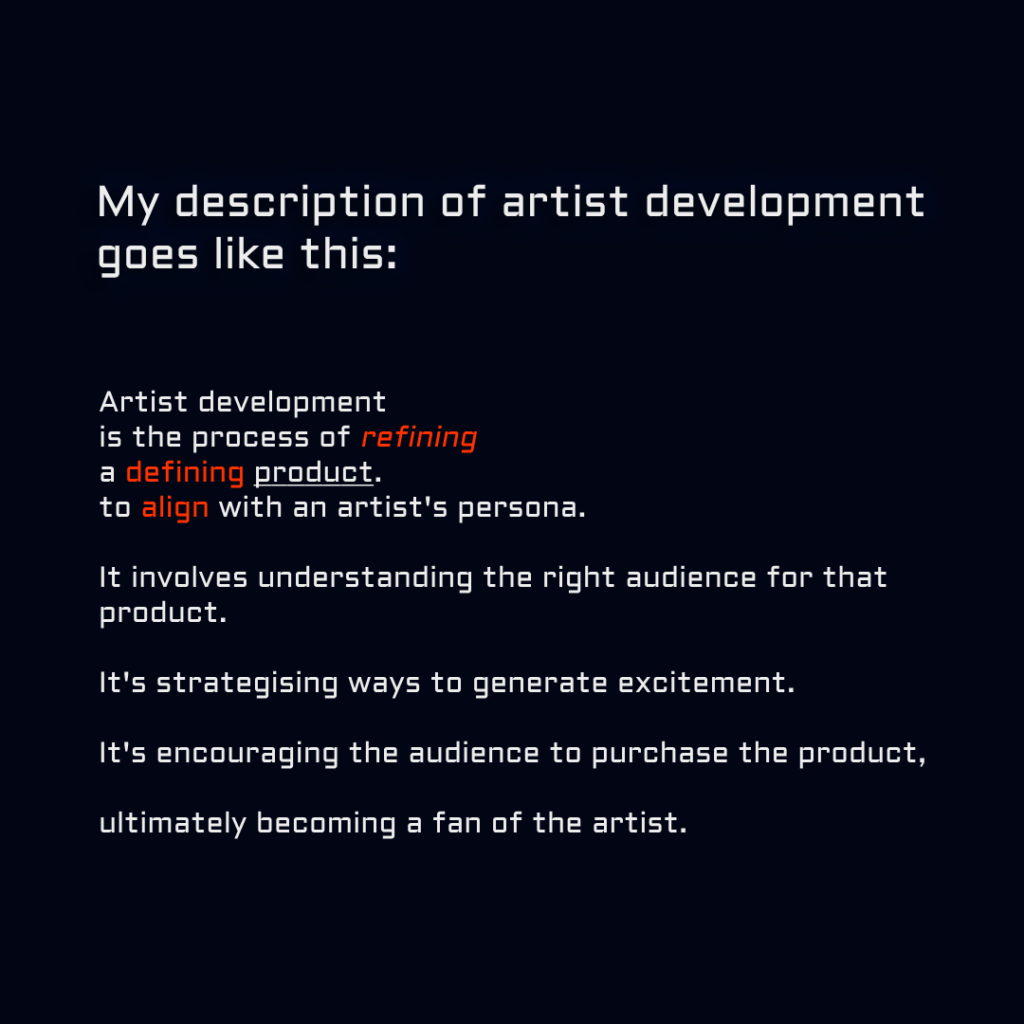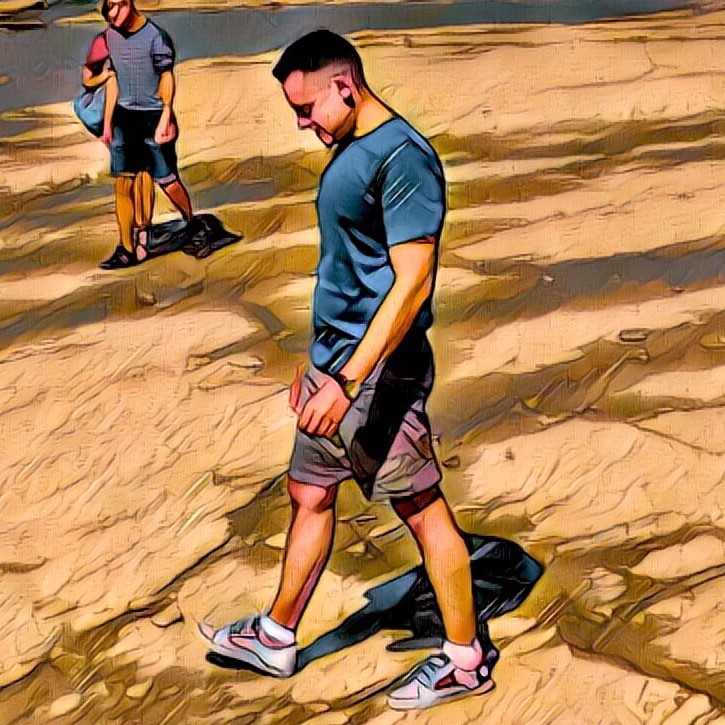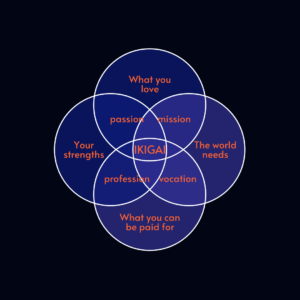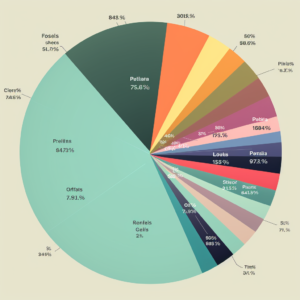How does artist development help singers & musicians become successful?
The DIY era has flooded the music industry.
The concept of artist development has transformed and, at times, been seen as unnecessary.
For at least two decades, stories of record labels sacking their A&R managers and abandoning artist development have been prevalent in the music industry narrative. Artists are now expected to “develop themselves”.
The term “artist development” is vague and can have different interpretations. However, according to the music industry media, artist development is often portrayed as the process of increasing your social media following to gain social proof and secure a record deal. This perspective is highly distorted and oversimplified.

However, the work of artist development is much deeper and you can click here for a much more comprehensive overview of artist development.
What is a "development artist"?
In the golden days of record labels, artists would create demos, which were low-fidelity recordings of “undeveloped” songs. These demos were often recorded on basic 4-track (or sometimes even 1-track) recorders.
Artists would then take these demos to record labels, hoping that the labels would invest in studio time to create a professional version of the songs. The record labels provided significant value to the artists in this process, way beyond just the studio space.
If an A&R professional believed that an artist was ready and showed promise, they would invest in them for a specific period of time. During this time, the artist would work on creating a full EP or album, as well as improving their stage performance and persona. Through this period, pre-release, the label would refer to them as a “development artists” (within their “development roster” as a collective).
In addition to the recording and rehearsal space, artists also had the opportunity to consult with music industry executives who could provide guidance on transforming the record into something commercially appealing to the target audience. They also explored options for collaborating with producers and session musicians who could add the necessary elements to elevate the song from a demo to a commercially viable product.
Artists of this kind were not given long-term formal record deals. Instead, they were held on temporary contracts and referred to as development artists until the product and the artist’s persona/performance were ready for a larger audience. This is the origin of the term “artist & repertoire” (A&R).
In the modern day, musicians have the ability to record a song in their bedroom and share it on platforms like SoundCloud, social media and DSPs, allowing them to directly reach the audience. However, despite their efforts, the audience often perceives them as mere hobbyists chasing a dream, and as a result, tends to overlook them. Even when musicians manage to gain some fans and followers, their support is often fleeting and unreliable.
It is my observation that a critical stage of the traditional path to becoming a prestigious and/or commercial artist is being skipped, which is significant to the overwhelming number of disillusioned aspiring artists.
What developing artists need, as they always have, is focus, artistic vision, accountability and commercial guidance. This is what a good artist development program can offer.
Evolution of the music industry and development artists
Traditionally, development artists were offered development deals by record labels and music publishers. However, with the decline in CD sales and the changing landscape of the music industry, the focus has shifted. Music companies now prioritise signing talent that already demonstrates traction and potential success.
Key performance indicators (KPIs) such as social media following, streaming numbers, and ticket sales have become crucial in assessing an artist’s commercial viability for record labels. Consequently, the entire music industry is now focused on these KPIs.
As mentioned earlier, skipping the traditional artist development stage can be detrimental to an artist’s sustainable progress.
Many in the music industry are fighting back and recognising that the exhausting self-development path towards a deal with a record label via social media is a terrible strategy that ultimately only benefits the record label.
But I’m also saying that we need development deals, or at least artist development consultation services to nurture and cultivate rock star talent.
For example, without development deals and A&Rs, there would have been no Linkin Park.
Xero, the band now known as Linkin Park, before Chester Bennington joined, received a development deal. Chester was introduced to the band by an A&R. We simply wouldn’t have had the band as we know it without either development deals or A&R pairings.
This can be said for so many other successful acts.
How to fund artist development
You might argue that without the investment for development artists from the record labels, they can’t afford to take this longer approach to development and have to try and get fans and followers themselves, then going on to seek investment.
However, there’s nothing wrong with getting a job, and there’s plenty of time around work to be an artist.
Stay out of debt. Commit to a minimum amount of music work per week, even if it’s evenings or weekends.
Think about reducing these costs of cancelling these services for a while, see them as rewards for music goals being met:
- Netflix, Spotify and other on-demand entertainment subscriptions
- Clothes and luxuries to look good on Instagram and TikTok
- £50+ computer games
- Junk food or expensive restaurant food
- Alcohol or other drugs
- Gym and exercise subscriptions that aren’t being used
- Expensive unnecessary tech equipment (like the newest iPhone)
- Holidays
My artist development program starts at ~£100 per month. Artist development doesn’t need to be expensive!
The time constraint challenge
One of the significant challenges faced by artists today is the lack of time to dedicate to growing their own success. Artists find themselves juggling multiple responsibilities, making it difficult to focus on crucial aspects of their careers. The pressure to achieve goals within a specific timeframe can be overwhelming and lead many artists to feel discouraged. This time constraint challenge poses a significant risk to an artist’s motivation and ability to achieve their desired level of success.
I collaborate with artists to manage their time, establish accountable timelines, handle their expectations, and maintain resilience and self-understanding when timelines are not met.
An effective artist development program recognises the time constraints faced by artists and helps them navigate their busy schedules. By providing strategies and support to manage competing priorities, artists can allocate time and resources efficiently to achieve their goals. This balance allows artists to focus on their craft while also addressing the necessary administrative, promotional, and business aspects of their careers.
The importance of effective artist development
Artist development, when done right, provides a structured and supportive framework to help artists navigate the complex music industry and achieve their goals. By setting specific, measurable, and attainable objectives tailored to the artist’s desires and circumstances, artist development programs empower artists to make progress and feel accomplished in their artistic journey.
Setting specific goals
Firstly, artists must understand why they desire certain goals. It’s not beneficial to start with a goal set by society or the music industry. Artists should clearly identify the fundamental needs they are trying to meet.
The next crucial aspect of artist development is setting specific goals that align with the artist’s vision. These goals should be clear, well-defined, and focused on the artist’s desired outcomes. Whether it’s increasing fan engagement, improving live performances, or enhancing songwriting skills, specific goals provide a roadmap for artists to follow and measure their progress.
Measuring success
Measurability is another essential element in artist development. By establishing clear metrics and benchmarks, artists can track their progress and evaluate the effectiveness of their efforts. Whether it’s monitoring social media growth, streaming numbers, or audience reception at live shows, measurable indicators provide valuable insights into an artist’s development journey.
Attainability and realistic expectations
Attainable goals are crucial for maintaining an artist’s motivation and momentum. While it’s essential to set ambitious objectives, they must also be realistic and achievable within the artist’s timeframe and resources. By breaking down larger goals into smaller, manageable milestones, artists can experience a sense of progress and build confidence in their abilities.
Emotional satisfaction and fulfilment
Artist development should not solely focus on external achievements but also prioritise the artist’s emotional well-being and fulfilment. As far as I’m concerned, an artist career both starts and ends here.
It is vital for artists to pursue goals that genuinely resonate with their artistic vision and bring them joy and satisfaction. By aligning goals with personal happiness and fulfilment, artists can foster a deeper connection with their craft and maintain long-term artistic sustainability.
Conclusion
In the ever-evolving music industry, artist development plays a vital role in helping singers and music artists unlock their full potential and achieve success. By providing a structured framework, setting specific goals, and addressing time constraints, artist development programs empower artists to navigate the industry’s challenges and accomplish their artistic aspirations. Whether it’s securing a bigger deal, building a dedicated fan base, or achieving commercial success, effective artist development can be the catalyst that propels singers and music artists towards the recognition and fulfilment they deserve.
Remember, your journey as an artist is unique. With the right artist development support, you can ensure that you follow your own unique path, not one imposed on you by society or the music industry.
Blog posts about artist development
The music industry is probably not your Ikigai
The majority of my audience is either trying to become...
Read MoreHow I stopped LinkedIn hijacking my attention and creativity so I can stay focused on artist development and music production
What’s wrong with content lately? I’ve taken a stand against...
Read MoreHow to gain music industry market share as an independent artist
Strategies for market share and listener retention in the attention...
Read MoreHow to use music feedback to get heard by A&Rs and get more streams
Feedback is by its nature critical. Its intention isn't to...
Read More




